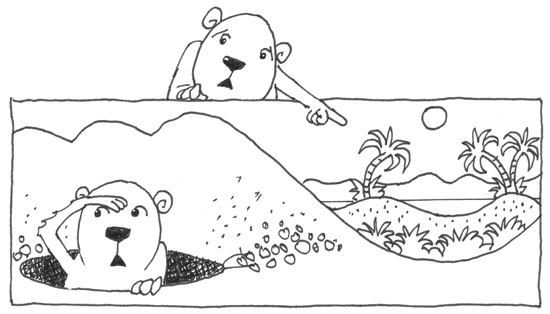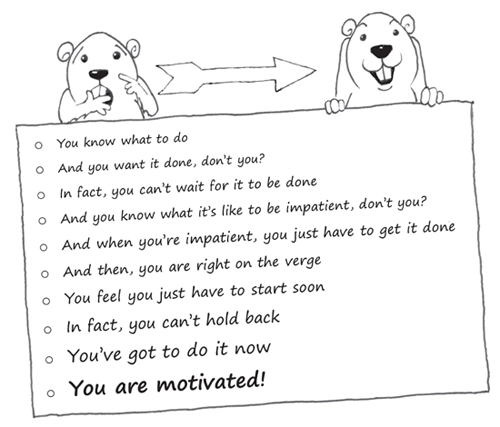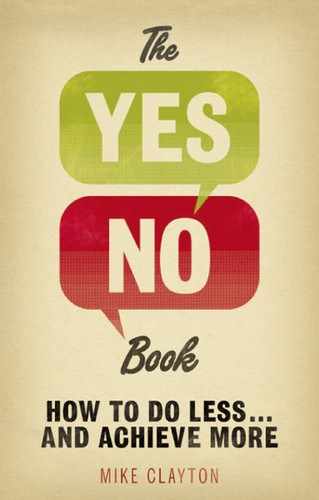CHAPTER 5
How to say ‘YES’
So far, much of this book has been about the need to say ‘NO’. So it may seem strange to find a chapter about how to say ‘yes’. But since you are going to say it many times in your life, and very often you are going to mean it too, it is important to learn how to say it well.
How you say ‘yes’ matters
How you say ‘yes’ matters. It will have a big impact on how people perceive you. Think about how differently you would feel, having asked me to give you some help with something that is really important to you if, on the one hand, I reply with a grudging:
‘Yeah… allright’.
Or, on the other hand, I respond with a committed:
‘Yes, I will’.
‘Yeah… alright’ or ‘If I must’ sound churlish. Yet, if I am going to offer you my help, the resulting work that I have to do will be just the same, whether my response is weak and resentful or strong and positive. So I may as well use the better words.
There is a spectrum of ways you can say ‘yes’:
If I must I suppose so
Alright OK Yup Yes YES
The one you choose matters. If yes is what you mean, then don’t just say it in a feeble way: give it a 100 per cent committed ‘YES’.
If you are not totally committed, say ‘NO’. This will leave you with the time and energy to choose what to really embrace and say ‘Absolutely, definitely, positively YES!’
YES is an opportunity
YES gives you a chance to make a difference. So, whilst it is important to use it with care, to avoid taking on inappropriate and unwanted commitments, you may want to look for opportunities to use it where you can have a positive impact.
In these cases, use YES on your own terms. Rather than say ‘NO’, for example, could you say ‘YES, if…’.
YES if…
‘YES if…’ creates the opportunity for me to transform my request from something you want to say ‘NO’ to, to something you can readily say ‘YES’ to. If you look back at the criteria for YES or NO that we listed in Chapter 4, ‘YES if…’ allows you to take a request that does not fulfil those criteria and offer me the chance to reframe what I ask you, so I can meet your criteria.
‘YES if…’ can set conditions like timing, place, the resources you make available, the way I do something and even what is in it for me or for other people. You can even use it as a way to change the request completely.
‘Will you help us to gather evidence to support dismissing Peter?’
‘Yes, if you allow me to work with Peter to allow him first to show that he can do a good job.’
This exchange is substantially a real one in which I was able to change an unpleasant formal personnel task into a powerful learning experience for Peter and myself and, in so doing, improve both of our careers.
Saying ‘YES’ is the start
Saying the word ‘YES’ is, perhaps, the easy part. You also need to deliver on the commitment it creates. Anything less will damage your reputation and the relationships that go with it. We’ve already learned that this is why it is so important to be able to say ‘NO’.
If anything, it is better to say YES to less and to leave yourself the possibility that you will be able to deliver more than you promised. That is the way to delight and impress people.
So how can you create the conditions to fulfil the promise of your ‘YES’? We’ll take a look, in Chapter 8, at how to plan for YES, but in this section, I will show you five ways to kick start your efforts.
Make it right
The first step is to make sure that you are happy with your decision to say ‘YES’ in the first place. Once you have said ‘YES’, there is no benefit in asking yourself ‘What if?’ and looking at the choices you did not make. Instead, focus on the positive consequences of the choice you did make. Now take responsibility for your decision:
‘If it’s to be, it’s down to me.’
Make it fun
How you describe the task to yourself can have a huge effect on your performance levels. Researchers have found that habitual underachievers in school can outperform the best students when a task is described as ‘fun’. When tasks were framed as a test of ability, the usual high achievers did best. When the same tasks were cast as a ‘fun’ activity, the low achievers performed better and, indeed, outperformed the high achievers.
Create a mindset that saying ‘YES’ to something means it is something you can enjoy doing. Look for the pleasures along the way – even in the most demanding activities.
Make it urgent
A sense of urgency can give you a real head start into a task. For many people, their favourite technique is to delay starting, until there is genuine urgency. However, even when this works for you, it can make the people around you anxious.
A better approach is to mentally picture the deadline looming and to concentrate on the need to take the first step immediately, to bring the task under control. Once you have done that, you will find it easier to tackle the next step, and so on. Never underestimate the power of momentum to drive human behaviour.
Make it personal
Perhaps the strongest motivator for anyone is to know ‘What’s in it for me?’ When you see your commitments as a reflection of who you are and your personal reputation, then meeting them becomes more than just an obligation to someone else. Rather, it is a matter of integrity.
Make it flow
In the last chapter, we saw how the opportunity to do things that help you develop your strengths and put you into a ‘flow state’ is a useful criterion for deciding ‘YES’ or ‘NO’. Once you have decided ‘YES’, you can often transform whatever task you have committed to into a flow task.
Mihaly Csikszentmihalyi, set out three conditions to create a flow state.
- You must know precisely what your goal is, in doing the task: So, having said ‘YES’, set yourself a very clear completion criterion and quality standard for what you are going to do and how well you are going to do it.
- The task must stretch you to the limit of your capability: Set yourself a goal that will stretch you, so that it is not easy. Neither, however, must it be alarmingly challenging. Too easy, and you will be bored; too difficult, and you will get stressed. Ideally, it must be demanding enough to take your whole concentration and, in so doing, when you complete the task you will have learned and improved your skills.
- You must constantly monitor your performance levels: So decide what measures will indicate your progress and how well you are doing as you proceed.
Saying ‘YES’ and doing it now
Procrastination is often seen as a bad thing. In fact, it can be a force for good, as we will see in Chapter 7. However, if procrastination is merely about wasting your time and avoiding doing what you have committed to do, it serves no purpose at all.
Purposeless procrastination
The definition of ‘purposeless procrastination’ is this:
‘Purposeless procrastination is putting something off for no good reason, and with no incidental benefit.’
It is easy to say ‘YES’ and dive straight into a pleasant, goal-directed task. The challenge is to say ‘YES’ and dive into the unpleasant, unappealing, difficult things that may well take you towards your goals, but you’d rather someone else would do for you, or that you could at least leave until later.
For example, you want a lovely, clean, properly functioning home… and the drains are blocked. You know you need to roll up your sleeve, lie on the floor, and put your arm in, up to your shoulder. It has to be done, but there are other things you’d rather do. Been there, done that. In my case, the promise to myself of a chocolate bar as a reward was a big help.
Another type of purposeless procrastination occurs when a goal-directed and a desire-directed opportunity compete for your attention and time. You could work on making that dress, or building a playhouse for your children, but you also notice one of your favourite films is on television in five minutes. That gives you enough time to make a cup of tea. While you are making it, think through: ‘How much pleasure will you really get watching the film, compared to the satisfaction of completing a worthwhile project?’
The reason why we procrastinate
In each case, the temptation to procrastinate is driven by a focus on the immediate sense of effort or even nastiness of doing what you need to do, compared with the relative pleasure of doing something else. You do not consider the greater, but deferred, pleasure of fulfilling your ‘YES’. It’s a bit like standing behind a small mound of earth and not wanting to climb over it, without realising that when you do, you will have a magnificent view.
This is your ‘Gopher Mound’ – it prevents you going for the thing that matters, because the immediate challenge intimidates you.

Your Gopher Mound could represent the time commitment, your sense of the difficulty of the task, a steep learning curve, your fear of failure, your frustration with past attempts, the challenge of meeting your own high standards, or your depleted self-confidence. Whatever it is, you need to raise yourself up, just a little bit, to see what lies beyond.
Procrastination to motivation
The perfect way to deal with your purposeless procrastination is to create in yourself a feeling of pent-up desire to get on with the task. Here is a ten-step process. When you find yourself procrastinating, open this page up and work through these ten steps.
Procrastination buster
- You know what to do: Review what needs to be done and decide what the first step will be.
- And you want it done, don’t you?: Think about the reason why you said YES in the first place.
- In fact, you can’t wait for it to be done: Consider what you will get when you have finished, and how good that will feel.
- And you know what it’s like to be impatient, don’t you?: Remember a time when you were desperately impatient to get something done. What did it feel like?
- And when you’re impatient, you just have to get it done: Focus on what is really important, so that you know that this task absolutely deserves all of your attention now.
- And then, you are right on the verge: When you want to get something done it pays to choose just the right moment, when you are absolutely ready to do it.
- You feel you just have to start soon: Take on one small component of the task to get you started and build momentum.
- In fact, you can’t hold back: Feel how uncomfortable it is to not start it, knowing how important it is that you get it done.
- You’ve got to do it now: You made a promise to someone. If you don’t keep that promise, how will you feel?
- You are motivated!: Get started and you are on your way to celebrating the success of achieving it.

Top techniques for procrastinators
Typical procrastinators need to know that getting on with it is not so bad after all. If you are a frequent flyer with procrastination airways, then you may want to try some of the following cures.
Advertise your promise
More than just saying ‘YES’, publicise your commitment widely. This way, the discomfort of failure will increase, putting more pressure on you to get on with it. Better still, make a commitment to when you will get started:
‘YES, I will do that. I will get started on it at 3 p.m. and let you know how I am getting on at the end of the day.’
Time-box your activity
If the task is too big and intimidating, set yourself a smaller one. Determine a useful part to get done in just 20 minutes and call it Task 1. Now create a series of tasks: 2, 3, 4… each of the same length. Whilst putting off the whole job, dive into Task 1 with gusto. Get it done then take a five-minute break. Now do Task 2. And so on.
Rewards
If the big reward is too far off, promise yourself intermediate rewards for doing the each part of the job. Nothing is as motivating as acknowledging our own success, and a small reward is an explicit way to do that.
First draft
One of the common reasons for procrastination is a sense of perfectionism: some procrastinators don’t want to start because they can’t see their way through to a perfect end product. So instead of setting yourself up to do the job, set yourself the task of producing a rough draft, with all of the main elements in place. When you have done that, your perfectionism will become your ally by driving you to tidy up the draft.
Objective observer
Another reason why some people put things off is because they tried and failed. Maybe they tried and failed several times. Frustration can motivate some of us to try different approaches again and again, until we get a solution. Others come to a point where it causes them to freeze. If this is your reason for procrastinating then you need outside help: a friend or colleague who can be objective and suggest some alternative routes to take.
Remove distractions
Distractions are not a reason to procrastinate, but they do give you both a means and an excuse. One of the best reasons to ensure your workspace is clear and tidy is that it removes physical and visual distractions. If you are one of the 20 per cent of the population who view themselves as chronic procrastinators, a Spartan work environment will help you a lot. If your work is computer-based, only open up the applications you need to do the job you are working on. Unless you need your e-mails, close them down. Unless web access is essential, shut down your browser.
Yes/No in an instant
Don’t say a feeble ‘yes’ when you can shout an enthusiastic ‘YES’. Make it your opportunity to make a difference and make sure you deliver on the promise it makes. Purposeless procrastination has many causes, but it’s time to knock it on the head: where’s your inner Gopher when you need it?
| Yes/No: | Will you say ‘yes’ next time, or will you say ‘YES’? |
| Yes/No: | Will you deliver on your ‘YES’? |
| Yes/No: | Will you put off procrastination and get on with it now? |
| Yes/No: | Are you ready to confront the psychology of NO? |
